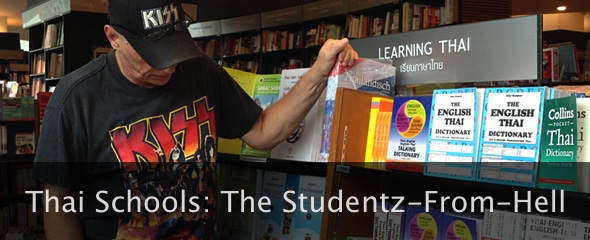
Thai Schools on the Studentz-From-Hell…
This is part two discussing the survey data I compiled about Thai Studentz-From-Hell. If you haven’t read the first post, go to Data Survey Part One: Thai Schools on the Studentz-From-Hell.
Below, where I talk about the data I’ve mined, I’m going to use some specific terms. I’ll use Westerners for people from the west and Asians for people from the east, okay? If I use the word students or foreigners, I’m talking about everyone learning Thai. Also, in an effort to be a kinder-gentler (not so blatantly racist) Tod Daniels, I’m not gonna use the term white people like I usually do. Honestly, I don’t like the hate mail it garners!
Btw: I’ve included a What can you do? section at the end of each category. That’s where I offer wisdom and information to hopefully help you overcome possible limitations in your learning Thai experience.
But before I get to the survey compilation, I just want to say this one thing.
The teaching Thai language to Westerners system is broken…
I know this will ruffle a lot of feathers, but the system (method, text books, etc.) used in the teach Thai to non-native speakers (and Westerners especially) is badly broken. It has stagnated for years with schools popping up all over the city using nothing more than copied textbooks from the original Union Thai Language School. Sometimes the only difference is the cover of the book!
I’m not saying the Union Method doesn’t work. Time and time again I’ve pointed out that their methodology turns out more proficient foreign speakers of Thai than any other method out there, period, end of story. Even the illustrious uni known as Chula teaches Thai that way. Sadly (for us learners of Thai) there’s been no total overhaul of the materials for years. The vocabulary is antiquated, the lessons don’t build on each other, and the advanced materials come from the Stone Age.
In saying that … I will speak up in the defence of several schools: Rak Thai Language and Duke Language especially. They took the tired material and re-worked it, putting it head and shoulders above the old stuff. But, it’s only a matter of time before contemporary Thai study material appears on the market. The new method will use the technology of today, in a way that revolutionises how Thai is taught. It’s coming soon. I know that for a fact. I’ve personally seen some of the material in the development stage.
What can you do? Unfortunately what’s out there is what’s out there and that’s that. So you’re either gonna use what’s available or you’re gonna come up with your own way to learn Thai. And that’s what some of the advice in this post is all about: Using what’s available in this day and time.
Finally, here we go!
Age and sex of students…
One of the most interesting things found in the data was that neither age nor sex seemed to play any role in a student’s ability to learn Thai. There was a good make-up of males and females and a broad age range of people from their early 20’s to their late 60’s (even older) of both Westerners and Asians. From what the teachers told me, age doesn’t affect anyone’s ability to learn the language at all. That at every school included in this data review, old people seemed to learn as easily as the younger students.
My personal experience: The b/s excuses you read on every forum concerning learning Thai where Westerners parrot out “I’m too old”, “I’m not good at languages”, “I can’t hear the tones”, blah-blah-blah were just plain and simple not represented in the feedback from teachers at ANY school.
What can you do? Stop using your advanced age and (supposed) inability to learn languages as excuses and start learning Thai already! And of course, if you are deaf, there’s obviously going to be a problem. But for the rest of you, get off your butts and ramp up your listening time!
Hemispherical origin (a polite way of saying ethnicity!)…
What started to come to light was, hands down, Asians (Japanese, Koreans, Chinese, Vietnamese, etc) learned the Thai language far better than Westerners. ANY Westerners!
On further reflection of this conundrum, in the data I did come to a conclusion of sorts. Asians as a rule are less question driven in their education systems and lean more towards rote learning. Also, Asians accept any teaching methodology without question. But, due to our question driven education system, Westerners sometimes try to buck the methods (especially rote) that are often used here to teach Thai.
What can you do? Face it. If you aren’t Asian, you’re unlikely to be able to change your learning mindset overnight. So when you do go to take in the material presented, be as open-minded as you can. Try and adopt a less question driven strategy and go for rote. Go with the flow. If just for now.
Speaking multiple languages…
Another interesting point made was that the more languages a Westerner knows that use a Latin based alphabet, the harder it is for them to get Thai to click. Now, I know some of you will come out in force against this, but again, that’s what I got from talking to the teachers. I don’t know why the data shows this but it clearly did.
I do think it’s possible that studying a multitude of Latin languages gets in the way with learning Thai somehow. It’s not so bad in the early speak via karaoke part of learning Thai (like is taught in 99.99% of the schools) because they use transliteration (karaoke), which is mostly legible to English speakers. It only becomes an impediment when a Westerner makes the leap from learning to speak Thai via karaoke, to actually reading the Thai script. The teachers mentioned that at this point Westerners come off the rails, learning far slower than their Asian counterparts.
From my study, the best Western learners are those who only speak their mother tongue, or at most another language closely related to English. The best Asian learners mostly know their mother tongue, although they oftentimes possess fairly proficient English language skills too. Compared to Westerners knowing more than one Western language, Asians who knew other Asian languages didn’t have a problem.
What can you do? Perhaps you speak more than one language that uses the Latin alphabet, and good on you if you do. BUT, do note that learning the Thai script will take a slightly different mindset than what is needed for French, Spanish, Polish, etc. So when you do enter a classroom to learn Thai, be prepared ahead of time for differences. Don’t fight it.
Impediments to learning…
The anecdotal data I gleaned in the meetings with teachers hands down showed that there were two big impediments to Westerners learning Thai. One is that Westerners often over-sold or completely overestimated their ability in Thai. Meaning, they went into the school saying, “I’m not a beginner!” “I can read Thai already!” “I want Thai script only textbooks!” Yet when the teachers tested these students, turns out the students couldn’t speak or read Thai to the level needed to keep up in their chosen class. Asians, on the other hand, had no trouble admitting they didn’t know what they didn’t know.
Also, some Westerners were adamant that they weren’t beginner level students, to the point they became confrontational, even when they could see from the informal interview they were basic Thai speakers (and that, only when under spoon-fed conditions).
The Thai teachers said that even when they tried to sell beginner courses as a refresher/review, few Westerners would go for it. Conversely, Asian beginners of Thai bought right into the premise that you start learning things at the beginning, not partway thru. When Westerners forced schools to let them into the intermediate classes, they were left in the dust because they just didn’t have the foundation they should have. Rather than suck it up and admit the truth, more than a few Western students turned the blame away from themselves by putting down the methodology, the school, the teacher, and even other students.
What can you do? Obviously, don’t overestimate your ability in Thai, period. If you can’t keep up, face the truth. Instead of pretending, start on book one page one and don’t progress into the next level until you really get it. Because believe you me, you ain’t fooling anyone!
The second really big impediment was that Westerners, to a person, thought they knew how Thai should be taught to Westerners. It is true that as adults we are fairly locked into the way we acquire new information. Some people are visual learners, some are tactile learners, some are aural learners, and some use all those avenues to learn new stuff. And equally important, rote learning goes against the Western grain.
What can you do? Sometimes the rules just plain don’t apply and this is one of those times. Attempt to be open to how the information is being presented, even if you think it’s not the right way. Give it a chance, a real chance.
I’m NOT saying to sign up at the first Thai language school you wander into. As I mentioned at the beginning of this post, the teaching Thai as a second language system is broken, or at least in a terrible state of disrepair and neglect. What I am saying is be open to the methodology used at a particular school and see if it jibes enough with the way you learn things. Do your due diligence, but don’t discount a school’s methodology right outta the gate. Well, you can discount one school’s methodology as total b/s, but at least give the rest of the schools out there a decent chance. Because seriously, until the changes come, that’s all there is.
Education level…
In regards to Westerners and their ability to get Thai to click, education levels seem to play a VERY important role. The reverse doesn’t appear to be true for Asians because no matter what education Asians have acquired, they learn Thai just fine. The data shows that where Westerners are concerned it’s almost an inverse proportion. The more education a person from the West has had, the less they take to Thai as it’s taught in schools. Westerners with a high school education or a bachelor’s degree learn Thai far easier than those with a Master’s or PhD. It also appears that foreigners with a ‘teaching anything’ background have more difficulties with learning Thai via the methodology available in today’s marketplace, than Westerners with degrees in non-teaching fields.
My personal experience: On the topic of education and Westerners learning Thai I have to agree with the teacher’s perceptions. I’ve ran into more than my fair share of Westerners with a high level of edu-ma-cation. In talking to some (not all of course) it’s clear they think they know best on how Thai should be taught to Westerners. And rather than taking personal responsibility for their failures, that it’s possible to be their own worst enemy, they instead blame the school, the teacher, the methodology, other students, or any distraction they can think up on why they can’t learn Thai. They even meet with the teacher or manager of the school between classes to offer suggestions on how teachers can improve how they teach. They also whine and cry about this or that on breaks with other students. Now, it’s fine for students to commiserate with one another on the difficulty of learning Thai, because for one, it can build classroom cohesiveness. It’s just that this particular demographic of student has often tried many schools, all the while not learning Thai. These kinda people are the bouncers I mentioned in Part One of Studentz-From-Hell.
What can you do? As with the discussion about Impediments to Learning listed above, even if you think it’s not the right way to learn, be open to how the information is being presented. Give it a chance. Remember, if you aim to learn Thai in a classroom setting, what other choice do you have?
Group versus private…
I looked at the subject of private versus group lessons using the same methodology, but there just wasn’t a big enough sampling of annoying students in the private section. This is because at most schools, in private classes students can tailor the lessons to the way they learn. While in groups, students are dragged along with the rest of the class and are more likely to kick up a fuss.
What can you do? If you do find yourself failing in a classroom setting, then do give everyone a rest (yourself included) by signing up for one-on-one lessons. The solution can’t get simpler than that.
Thai teachers…
Another complaint from the Thai teachers (ALL of them) was that some foreigners think that the reason they weren’t learning Thai is the teacher’s fault. There certainly are marginal and even extremely poor Thai teachers out there. But clearly, not every single foreigner who fails to learn Thai can point their finger at their teacher’s lack of skills.
What can you do? If you gave it the old college try with a teacher and it just plain ain’t working, switch teachers or schools even! You’ll certainly find out right away if your problem was the teacher, or you. Either way, a change of scenery is better than sitting thru an entire module seething.
Class size…
One thing I tried to pin the teachers down on was class size versus efficacy in their methodology. This was a touchy subject, especially when talking to the owners of the schools. Most schools employ teachers on a fixed monthly salary so whether they’re teaching a handful of foreigners or a group of 15, the hard cost to the school is the same. It was no surprise to me that the owners thought there was nothing wrong with cramming in as many students as there were chairs in every classroom. Because face it, the more students per class, the more their profit margin.
The teachers, on the other hand, totally disagreed with this premise. It had nothing to do with what the teachers are being paid and everything to do with the pride they take having students become proficient in the language. They all said that the best size for a group of students (Westerners and Asians) was between six to eight people at most. Group lessons are conversation or dialog based and they incorporate practice with other students or with teachers, and large classes fall way short of the mark as far as having enough useful practice time for each student.
My personal experience: I have witnessed the detriment a large class size (more than 10 people) can be to students. There’s just not enough of the teacher to go around and they’re pulled six ways from Sunday. In those early levels of learning it is crucial that the teacher has adequate coverage to correct pronunciation and structural errors EVERY time! With too many students in a class they just can’t do it. The teachers also can’t effectively keep that many students on topic either, so it becomes more like herding cats than teaching Thai.
What can you do? If you enrol in a group class (especially an intensive one) and there’s more than seven or eight people in the class, bail out! DON’T waste your money and your time! March right up to the front desk and inform them you’ll wait until either a new class starts or the next term rolls around. Again, stand up for yourself in this regard because it’s way important early on.
In summary…
I’ve tried to present the information from the data and the feedback I got from the teachers as accurately as I could. However, as is my penchant to do, I did ride some of my hobby horses as far as what I think works acquiring the Thai language. I am nothing if not opinionated, and that my opinion differs from yours is fine by me. I had more fun going to the schools, interacting with the staff, getting this information than I’ve had here in Thailand in ages!
Remember, Tod Daniels is NOT affiliated with ANY Thai language school. I’m about learning Thai by whatever means works for you.
Good Luck,
Tod Daniels | toddaniels at gmail dot com







It’s not surprising that westerners have a more difficult time learning Thai than many Asians. There are many factors creating this, some of which people have talked about in comments. But whether cultural (learning styles, etc…) or linguistic, it is clear that Asians will obviously have an advantage in learning Thai over westerners. Whether Korean, Japanese or Chinese come from Austronesian, Altaic or Sino-Tibetan origins, these language families have more in common with each other than those of the Indo-European family.
There was some interesting research done on the difficulty of native English speakers that you can read an article on here, http://aboutworldlanguages.com/language-difficulty
Thai ranks among one of the more difficult languages for native speakers to learn.
An excerpt, “Students at the Foreign Service Institute are typically 30- 40 years old, are native speakers of English with a good aptitude for formal language study, plus knowledge of one or more other foreign languages. They study in small classes of usually no more than 6. Their schedule calls for 25 hours of class per week with 3-4 hours per day of self-study. Even within this relatively homogeneous group there is still a good deal of variation in language learning ability, motivation, and personal circumstances.”
Thai was found to need 48 weeks, 1,200 hours of class time (and say about 170 hours of self-study during that period) in order to achieve a general professional proficiency.
Contrast that with learning most European languages, needing only 23-24 weeks, 575-600 class hours (with German requiring 6 more weeks).
So, Thai is expected to take double the amount of time. That is very significant. And when dealing with a broken system with teachers who don’t know how to teach well (they may have lots of experience, as mentioned somewhere in the article, or maybe it was in part I, but that doesn’t mean they know how to teach. Professional training in teaching language to non native speakers is woefully lacking here) and a curriculum that doesn’t help them…. maybe double it yet again! And I don’t believe most language schools here have classes for 5 hours a day as in this study. So, maybe it would take about 3 years of study in the systems here? It wouldn’t surprise me at all.
And for Asian students, perhaps it would only require a year or two?
Diligence in study and study/teaching styles are definitely important but only go so far. IMHO linguistic differences in how the brain functions with language makes a bigger difference. In my classes the two white guys (American and French) were consistently at the top of the class, with the Japanese, Korean and Chinese coming next in that order. All anecdotal of course, just like the informal study by Tod, which came with the expected results (except the ones about multiple languages and education levels), but was nonetheless quite interesting, by the way 🙂
Nice article Tod Danielz (see what I did there?)
Like others, I’m also surprised by the single language advantage. I agree with you that one advantage a polyglot has over a monoglot is knowing “how to go about learning a foreign language”. But imo, there’s an even bigger advantage; the fact she knows she can learn a language as an adult. She did it before, so she can do it again. This is huge.
Personally, I’m a class leader who did the world a big favor by switching to private lessons. You’re a bouncer, right? They made a movie about that. Flubber.
I’m not with you 100% “kris”, BUT I will say knowing “how to go about learning a foreign language” (which I agree people acquire by learning languages) gives them a heads up in learning thai. I don’t think Adam Bradshaw, Andrew Biggs, or Todd Tongdee (either; good stomach ท้องดี or good gold ทองดี) Lavelle can speak anything other than english and thai and yet they’re really good, super proficient speakerz of thai!
Another thing which in reality is a no-brainer but is NOT being done in ANY school I’ve toured is; “orientation”. Once a student enrolls they should be compelled to attend an orientation class where the methodology, the system (learning via “karaoke”) and the way it works is spelled out to them before they ever set foot in a classroom. If someone goes into learning this language knowing what to expect it can only be a good thing. I’ve asked several schools why they don’t do this but so far have gotten only excuses for answers…
I said in the beginning that this was a collection of the data I’d gotten from the teachers at various schools across Bangkok. Believe me IF any of them had seen “highly educated foreigners” pass thru their classes who were great students and stood head ‘n shoulders above the rest (not just because they were tall foreigners versus short asianz), those teachers woulda mentioned it.
Unfortunately to a person they were of the mind the more education a westerner had (especially in ANY teaching field) the worse they took to the thai language learning process available in schools today.
Now we can look at this and say like we did in the beginning; the system is broken, it has stagnated and been in suspended animation for so long that westerners buck the archaic, out-dated, one way communication methodology used to teach thai to foreigners in the marketplace.
That you take them as anecdotes is fine, IF you take them to heart! In the observation lessons I’ve sat at schools to review them, I’ve come across most of those “studentz from hell” and heard most of the lame excuses foreigners spout out about why they can’t learn thai too.
Michel Boismard; I am with you on this completely. It is motivation far more than methodology that makes the difference. Especially so, seeing as we’re all goin’ into this with the idea that the system to teach thai to us, as it exists is broken yet still churns out proficient speakers of thai! That in and of itself has to say something about the motivation of foreigners learning this oh-so hard language as adultz.
Great research of yourz,Tod,thanx for the lessonz learnt!
If I may add my own grain of salt to it all as a simple(obvious?)deduction: The heart is or should drive the head in the learning process.I used to tell my students to see their eagerness and motivation as their own locomotive,the wagons of intellect being dragged on by it. No locos,no logos !
The best methods or teachers will not yield good results when a student cannot put his/her heart wholly in the matter.On the other pole,bad methods or teachers will not impede the progress of one who dives into it with passion.He/she will look for any opportunity in and out of class to explore the subject and ask questions without being told to.Like an electric device switched on.You can tell they are feeling the”buzz”…
Busting open doors? But I sense these doors are closed for some!
It is indeed personal opinion (as Todd has already stated) but it’s still helpful to read the responses from Thai teachers.
I’m unsure about their claims to the problems with those speaking multiple languages and learning too many Latin based languages, but the rest, well.
Do Westerners complain more than Asians about learning Thai? Do Westerners fall behind more than Asian students? Compared to Asians, do many Westerners have an erroneous opinion of their Thai speaking abilities? Do Westerners object to Thai teaching methods (rote learning)?
^ I think data may be the wrong word. It sounds more like a collection of anecdotes. It’s mildly interesting but I wouldn’t put too much weight on it. But yes, people who are good/successful at foreign languages are rarely good/successful at only one but then how many of those people are going to pass through these schools? And on top of that, a highly-educated person who is good at languages is much less noticeable (when she is successful) than a semi-literate high-school dropout who becomes fluent at a foreign language so it’s probably going to be the latter, rather than the former, who the teacher remembers.
I wonder if the data you based your conclusions on is correct. I think the more languages you know the easier it is to learn an extra language. Most of the farang I really admire for their knowledge of Thai are fluent in at leasy 3 languages (in fact Rikker is the only exception) My experience is that almost 100% of the farang left in the higher grades are highly educated.
Given how atrocious the outcomes are for language learning in the English-speaking countries, it’s probably not the worst thing in the world if schools here don’t replicate those failures, though I agree that the materials which tend to be used to teach Thai are hardly the most inspirational. And there’s a lot to be said for drills; I’ve recently been resurrecting my schoolboy French with the FSI course, which is hardly the most avant garde of methodologies. It’s boring as hell and you need a fair bit of motivation to keep going but there’s no doubt that it works.
On the Asian vs white thing, my wife’s job involves some indirect responsibility for Chinese exchange students (200 or so at a time) who come to Thailand as part of their undergrad studies in Thai language and I quite often get involved with them in one way or another. They’re not the most academically gifted students but the ones who want to learn work very, very, very hard. There are obviously some slackers but there’s also – compared to what I remember of university – a disproportionately large number who slave over their books day and night. I think this is probably the biggest difference with the European and American learners of Thai, most of whom (missionaries aside) just don’t seem to work very hard at it.
I agree with many points, Tod!
I would recommend Khruu Nung from Thai Language Clinic on Ram Soi 1. She’s constantly editing her books. She has some that don’t use phonetics even at the lower levels.
I did Module 5 at a school in Asok previously I was with a tutor. The class was okay until part way through the month when people had dropped out and they combined classes! Speaking time decreased. 🙁 Also, I still met with my tutor once a week to answer questions.
I tried to get away from phonetics ASAP! They drove/drive me batty. 555 Also, I constantly listened to Thai in my iTunes to help my ear adjust.
My view after studying awhile is that people in the Union style should study a module then take time to review and then continue on. Rush, rush, rush. Cram, cram, cram doesn’t help with long term memory.
It took my 6 years of study before I took the language exam. I work in an international setting and so my chance to hear/speak time is limited. I feel this was good in a way that I took longer than the 1 or 2 years of intense study. It also has its downsides though.
Tod, thanks for putting in all this hard work. Reading through the results, it seems like many Thai schools here teach the Asian way of learning (by rote) and ignore how Westerners learn.
Kudos to Duke, Rak Thai, and any other schools that are bucking the trend.